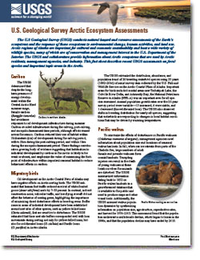U.S. Geological Survey Arctic Ecosystem Assessments
Links
- Document: Report (1.6 MB pdf)
- Download citation as: RIS | Dublin Core
Abstract
The U.S Geological Survey (USGS) conducts natural hazard and resource assessments of the Earth’s ecosystems and the response of those ecosystems to environmental change, human activities, and land use. Arctic regions of Alaska are important for cultural and economic sustainability and host a wide variety of wildlife species, many of which are of conservation and management interest to the U.S. Department of the Interior. The USGS and collaborators provide information about Arctic ecosystems that are used by Arctic residents, management agencies, and industry. This fact sheet describes recent USGS assessments on focal species and important topic areas in the Arctic.
Suggested Citation
Pearce, J.M. and Van Hemert, C.R., 2021, U.S. Geological Survey Arctic ecosystem assessments: U.S. Geological Survey Fact Sheet 2021-3016, 2 p., https://doi.org/10.3133/fs20213016.
ISSN: 2327-6932 (online)
Study Area
Table of Contents
- Caribou
- Migratory birds
- Pacific walrus
- Polar bears
- Biosurveillance
- Permafrost
- Upcoming Assessments
| Publication type | Report |
|---|---|
| Publication Subtype | USGS Numbered Series |
| Title | U.S. Geological Survey Arctic ecosystem assessments |
| Series title | Fact Sheet |
| Series number | 2021-3016 |
| DOI | 10.3133/fs20213016 |
| Publication Date | March 26, 2021 |
| Year Published | 2021 |
| Language | English |
| Publisher | U.S. Geological Survey |
| Publisher location | Reston, VA |
| Contributing office(s) | Alaska Science Center Biology WTEB |
| Description | 2 p. |
| Country | United States |
| State | Alaska |
| Other Geospatial | Arctic |


